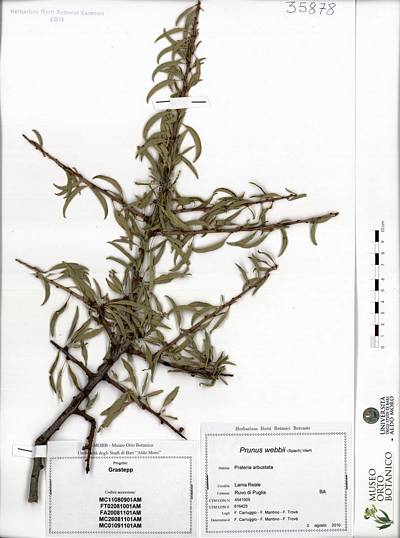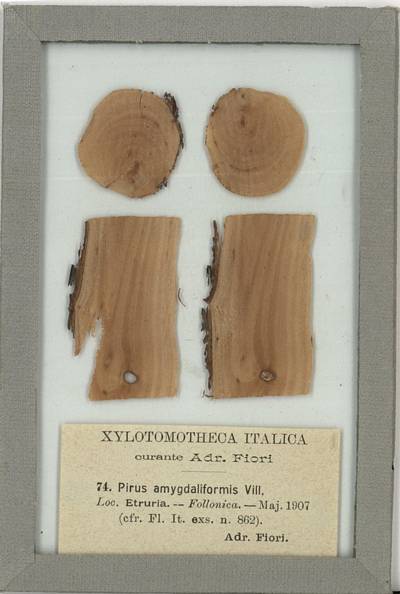
 Flora dell'Alta Murgia pugliese
Flora dell'Alta Murgia pugliese
Prunus webbii (Spach) Vierh.

|
Ferula communis L.

|
Pyrus amigdaliformis Vill.
 foto Giovanni Signorile
foto Giovanni Signorile
|
 Fauna
Fauna Mammals
Several species of mammals are particularly linked to agro-pastoral landscapes and the rural settlements. The fox (Vulpes vulpes) and the weasel (Mustela nivalis), along with many species of insectivores and rodents, frequently use dry stone walls and specchie to build dens and shelters. The fox, mainly active at night, it feeds mainly on small mammals and rodents, but it also insects, fish, birds, reptiles, berries and fruits. In some cases it can also feed on carrion. The wolf (Canis lupus) and the stone marten (Martes foina) are well known for their historical adversarial relationship with the farmers, though it tends to prefer less manmade habitats. Particularly important are the different species of bats, directly threatened by the destruction and transformation of natural and artificial cavities.
Mustela nivalis Vulpes vulpes Martes foina Canis lupus
Birds
Among the most typical birds of the steppe areas there are several species nesting on the ground, such as the little bustard (Tetrax tetrax), the grille (Melanocorypha grille), skylark (Alauda arvensis) and the quail (Coturnix coturnix). Other species, such as the European roller (Coracias garrulus), the owl (Athene noctua) and the barn owl (Tyto alba) nesting in the spaces typical of the farms and rural buildings. The European roller feeds on insects, catching them in flight, and is characterized by an extremely colorful plumage: blue-turquoise at the level of the chest and light-brown on the back. The Strigiformes (owls, barn owls, tawny owls, etc.) have several adaptations that allow them to be able to catch their prey in low light or complete darkness. These adaptations consist of a great vision, one highly developed hearing and a silent flight. In particular, the latter adaptation, due to the presence of fraying at the pens level, allows them to get close to the extremely silent manner prey, to then grab through the powerful claws. Several are finally raptors, like the buzzard (Buteo buteo), the honey buzzard (Pernis apivorus) and the fast peregrine falcon (Falco peregrinus), which use open spaces as hunting grounds. The buzzard is a very common bird of prey, can reach a wingspan of 130 cm and is easy to observe perched on exposed perches (eg. Telegraph poles) which scrutinizes the territory in search of prey.
FOCUS: The owls, ghosts of the night
The Strigiformes (owls, barn owls, tawny owls, etc.) have several adaptations that allow it to be able to catch their prey in low light or complete darkness. These adaptations consist of a great vision, one highly developed hearing and a silent flight. In particular, the latter adaptation, due to the presence of fraying at the pens level, allows him to get close to the extremely silent manner prey, to then grab through the powerful claws.
Tyto alba Athene noctua
Falco peregrinus Buteo buteo Pernis apivorus
Coturnix coturnix Alauda arvensis
Melanocorypha calandra Tetrax tetrax Coracias garrulus Coracias garrulus
Amphibians and reptiles
In both natural water collections, both anthropogenic (cutini, pools, channels) in the Apulian karst areas we can find a fair number of species of amphibians. Among the Salamandridi you may encounter species such as the newt (Lissotriton italicus) and the southern crested newt (Triturus carnifex), the latter being particularly related to artificial water collected. Among anurans is possible to meet the common toad (Bufo bufo), terrestrial species that can also be run from several hundred meters from the water, and the very common green frog (Pelophylax lessonae kl. Esculentus) always recover in the immediate vicinity of the water’s mirror. Apulian grasslands are home to a good number of reptiles, especially in the rural level or in areas with abundant bedrock. In these areas it is possible to observe the Hermann tortoise (Testudo hermanni), three species of gekkonidae as the gecko Kotschy (cyrtopodion kotschyi) the common gecko (Tarentola mauritanica) and warty gecko (Hemidactylus turcicus) and some lizards including the lizard country (Podarcis sicula) and the colorful green lizard (Lacerta viridis). Also, you can meet some species of snakes, such as the four-lined snake (Elaphe quatuorlineata), the lively and fast rat snake (green whip snake), the colorful leopard snake (European Ratsnake) and common viper (Vipera aspis hugyi), the only ofide poisonous Puglia. Very often snakes attend rural areas, as these represent a secure source of prey (rodents and livestock species of small size).
Tarentola mauritanica Elaphe quatuorlineata Hierophis viridiflavus Testudo hermanni
Terrestrial invertebrate fauna

The vast group of terrestrial invertebrates, dominated by insects, has a key role in prairie ecosystems, representing nodes important in food webs. Many species, such as Melanargia arge, zerynthia polyxena, Prionotropis appula, Ephippiger apulus and Euplagia quadripunctaria, are endemic or of conservation interest. In particular, Melanargia arge can be observed in flight from mid-May to mid-June in environments characterized by arid steppes with scattered bushes and sparse trees, and rocky outcrops.
Religious Mantis (Mantis mantis), entirely green or brownish, hunts its perfectly camouflaged ambush prey on branches of trees, shrubs or grass stems. Mantids prey through the front legs, so called “raptatorie”, which triggered with remarkable rapidity, leaving little chance to escape the prey. Given the very high predatory instinct of the female, the male, before mating, approaches her with great caution and after copulation looking to get away with circumspection to escape the predatory intentions of the partners, but only rarely succeeds in. Females tend to devour the males as they require greater quantities of food related to eggs deposition.
As examples of the great specialization and diversity of insects, you can observe countless adaptations of chewing herbivores (for example Orthoptera, beetles Chrysomelidae) and sucking (Homoptera, Heteroptera), pollinators (Lepidoptera, Hymenoptera) and the Raiders (Mantodea, Neuroptera).